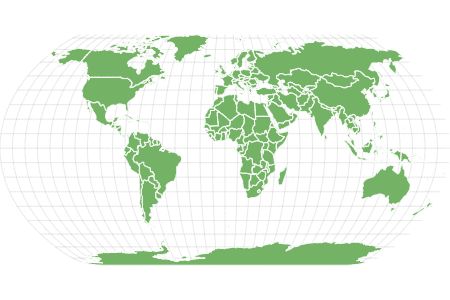Gentoo Penguin
Pygoscelis papua
Found throughout the sub-Antarctic!
Advertisement
Gentoo Penguin Scientific Classification
- Kingdom
- Animalia
- Phylum
- Chordata
- Class
- Aves
- Order
- Sphenisciformes
- Family
- Spheniscidae
- Genus
- Pygoscelis
- Scientific Name
- Pygoscelis papua
Read our Complete Guide to Classification of Animals.
Gentoo Penguin Conservation Status
Gentoo Penguin Facts
- Main Prey
- Krill, Fish, Shrimp
- Distinctive Feature
- Small head with orange beak and feet
- Habitat
- Rocky Antarctic Islands
- Predators
- Leopard Seal, Killer Whale, Sharks
- Diet
- Carnivore
- Average Litter Size
- 2
- Lifestyle
- Colony
- Favorite Food
- Krill
- Type
- Bird
- Slogan
- Found throughout the sub-Antarctic!
View all of the Gentoo Penguin images!
“The Gentoo Penguin is known to be the fastest swimming penguin in the world”
Gentoo Penguins are, much like the other penguin species, dressed for dinner in tuxedo feathers of black coats and starched white chests. They sport a jaunty white stripe from eye to eye across the tops of their heads and flamboyant orange-red beaks – dashing figures against a bleak arctic landscape.
Clumsy waddlers on land, Gentoo Penguins are graceful athletes in the water and are the fastest diving bird – reaching speeds of 22 mph. They are rarely aggressive and mostly keep their cool, however, they are known to get loud and rowdy during their nesting period.
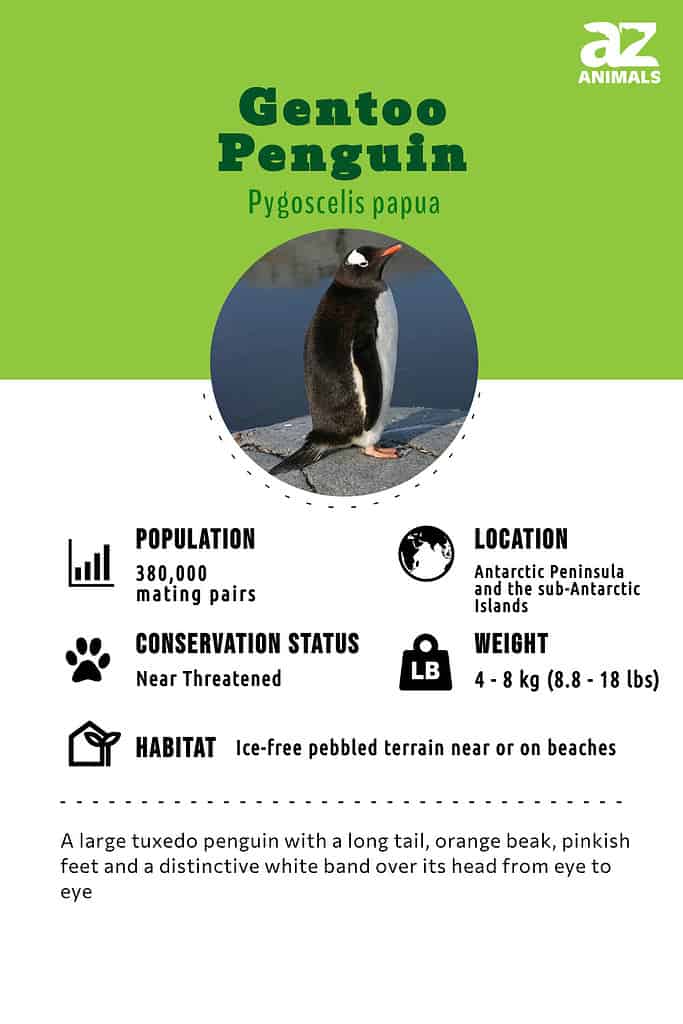
Incredible Facts About Gentoo Penguins!
- Gentoo Penguins are the third-largest penguins in the world – after the emperor and king penguins.
- Gentoo Penguins, when diving in deep waters, can control and reduce their heartbeat considerably. It can very well go from 80 to 100 to 20 heartbeats per minute.
- They are the fastest swimming penguins in the world and learn to swim without any help from their parents.
- Gentoo penguins are very relaxed creatures and are rarely ever aggressive.
- They use a variety of materials during their nesting period ranging from molten feathers to pebbles.
- Males and females mate for life and share parenting duties – including incubating their eggs.
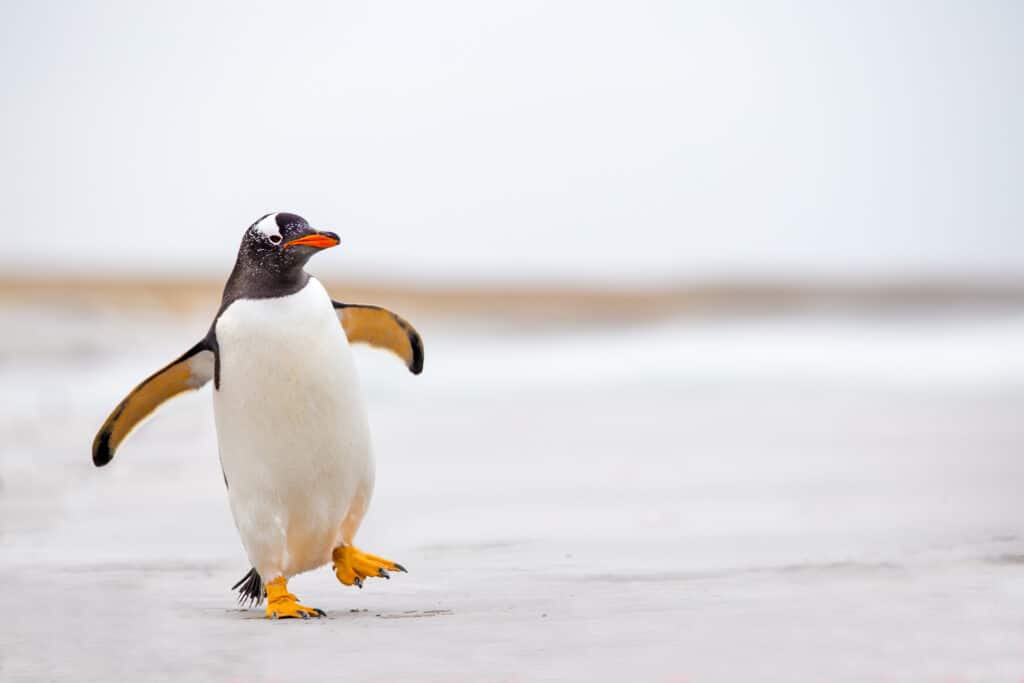
Gentoo penguins waddle when they walk and swish their long tails from side to side.
©iStock.com/fieldwork
Scientific name
The scientific name of the Gentoo Penguin, belonging to the genus Pygoscelis, is Pygoscelis papua. Their genus got this name, Pygoscelis because their prominent tails swish from side to side when they walk. Pygoscelis means “rump-tailed.”
However, the origin of the word Gentoo has so far been unclear. Some say that the word was used by the Anglo-Indians to distinguish between Hindus and Muslims. Another theory states that the name might have come from some turban-related term as the white patch on the penguin’s head is said to be a semblance to a turban.
Species
Gentoo Penguins can further be divided into four subspecies. Before 2021, only two subspecies were recognized, but a 2020 study suggested otherwise. After some debate over whether there were four separate species or subspecies – The International Ornithological Congress determined in 2021, that there are four subspecies of Pygoscelis papua.
- Northern Gentoo Penguin, Pygoscelis papua papua – the larger Gentoo penguins with varied habitats including the Falkland Islands, Martillo Island, and Isla de los Estados, Argentina.
- Southern Gentoo Penguin, Pygoscelis papua ellsworth – the smaller Gentoo penguins that live and breed on the coasts of the Antarctic Penninsula, the South Orkney Islands, South Shetland Islands, and South Sandwich Islands.
- Eastern Gentoo Penguin, P.p. taeniata – inhabits the Crozet Islands, Prince Edward Islands, Kerguelen Islands, Heard Island, and Macquarie Island.
- South Georgia Gentoo Penguin, P. p. poncetii – can only be found on South Georgia Island.
Evolution
Fossil records indicate that all penguin’s common ancestors lived as long as 40 million years ago and were around five feet tall. They are believed to have originated in Antarctica, which was covered in forests at that time and connected to what would become New Zealand, Australia, South America, and surrounding islands. These ancient ancestors of penguins had diverged from the ancestors of petrels and albatrosses around 71 million years ago.
The arrival of the ice age 35 million years ago brought brutal changes to the ancient ancestors of the penguin. The continents of Australia and South America drifted away from Antarctica while ocean currents encircles it. This cooling climate likely killed the older penguins – leaving them to compete with whales for the same prey.
While most of the ancient penguins became extinct, others, like the macaroni penguin, swam to warmer waters to found new lineages. Species like the emperor penguin stayed in Antarctica and evolved adaptations suited to live in the cold environment. The Gentoo penguins ventured as far as subantarctic islands with some staying on the continent.
Appearance and Behavior
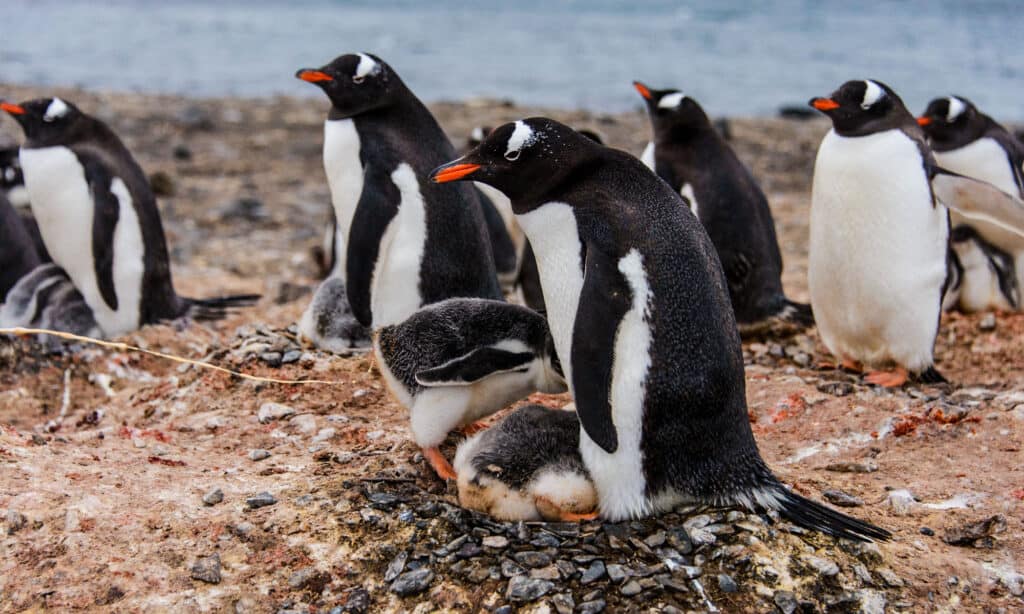
Gentoo penguins have long tails and are the only penguin with a bright red-orange bill and white cap.
©Alexey Seafarer/Shutterstock.com
From the back to the head, the Gentoo Penguins are black with a white patch on their belly. They also have a white stripe that runs from their eye to eye at the top of their head. This is referred to as a bonnet or turban and is distinctive to the Gentoo.
Gentoo penguins have pinkish webbed feet and a tail that is considered to be the longest amongst the Penguin family. The underside of their flippers matches their feet. The Gentoo Penguins are the only penguins with a bright orange bill.
The adults have very distinct eye patches while the younger ones have relatively dull patches that grow more defined. Upon birth, baby gentoos are grey and slowly turn to white within a week. Adult Gentoos are usually 30 – 35 inches in height and can weigh up to 18 pounds. Birds from the north average 1.5 pounds heavier than their southern counterparts. All Gentoos – male and female – lose weight while taking care of their babies and can weigh as little as 9.9 pounds during that time.
Behavior-wise, these penguins are usually laid back and are hardly ever aggressive. They are also known to be shy and usually do not make any effort to mark and/or defend their territories.
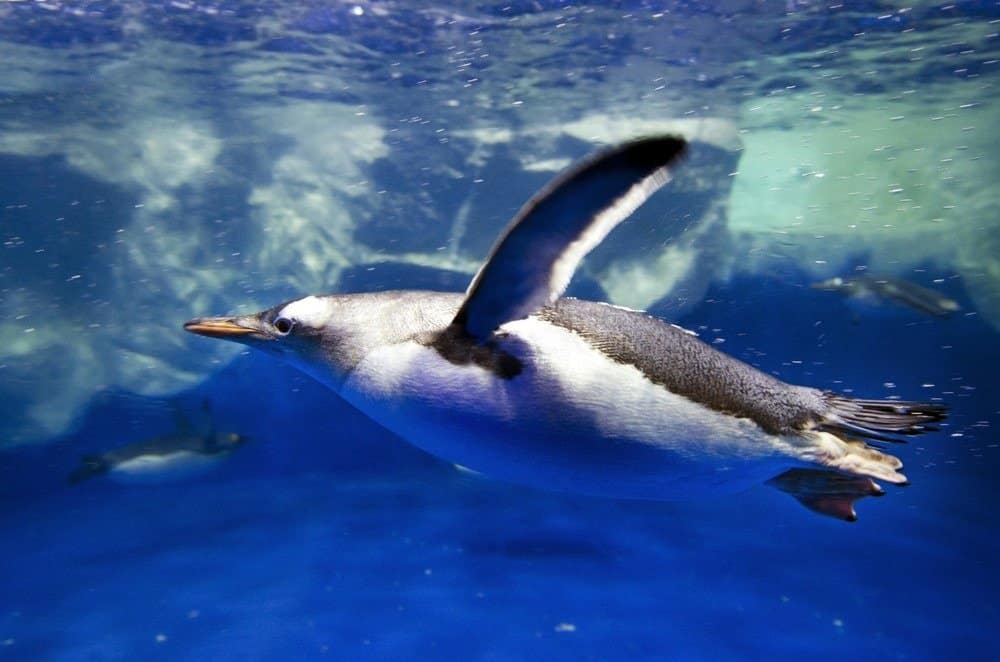
Gentoos are the fastest-swimming marine bird with a top speed of 22 mph.
©ChameleonsEye/Shutterstock.com
Habitat
Gentoo Penguins can be found in a variety of regions in the Southern Hemisphere. The Antarctic Peninsula and the sub-Antarctic Islands are home to the largest numbers. They are partial to ice-free areas like coastal plains, sheltered valleys, and cliffs. Some gentoos prefer pebbled beaches or twig-laden areas. Breeding settlements are sometimes located near the shoreline but can also be inland. Colonies in South Georgia breed further inland than other Gentoos, where they nest in grassy areas.
Diet
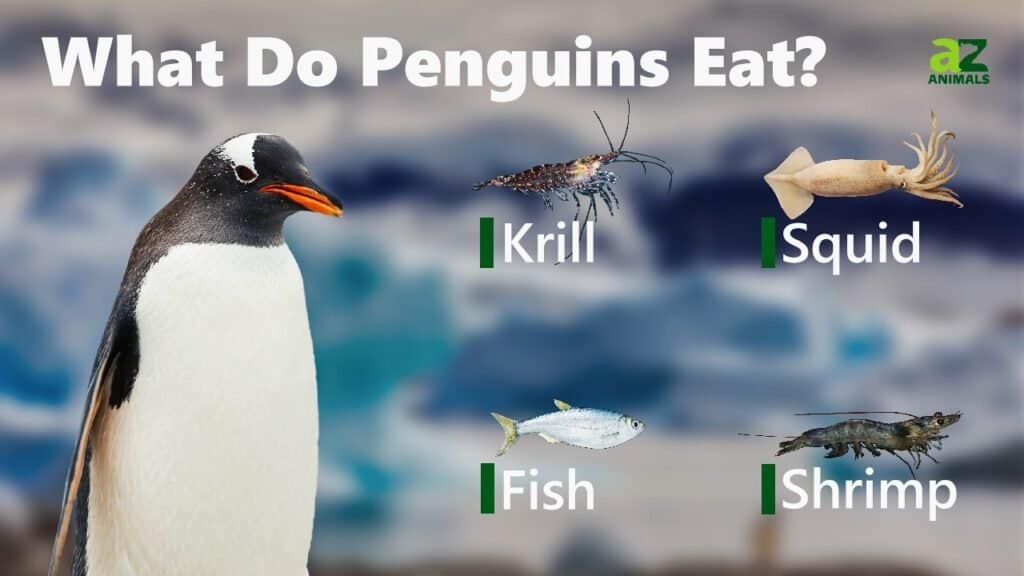
The Gentoo Penguin diet includes fish, squid as well as crustaceans. Adults spend the entire day hunting, usually close to shore but sometimes miles away. They can remain below water for up to seven minutes and dive as deep as 655 feet.
Gentoo diets are high in salt because they eat animals with about the same salinity as seawater. Like other marine birds, they have developed a salt gland above their eyes that takes the high concentration of sodium within the body and produces a highly saline solution that drips out from the tip of their beaks.
Predators and threats
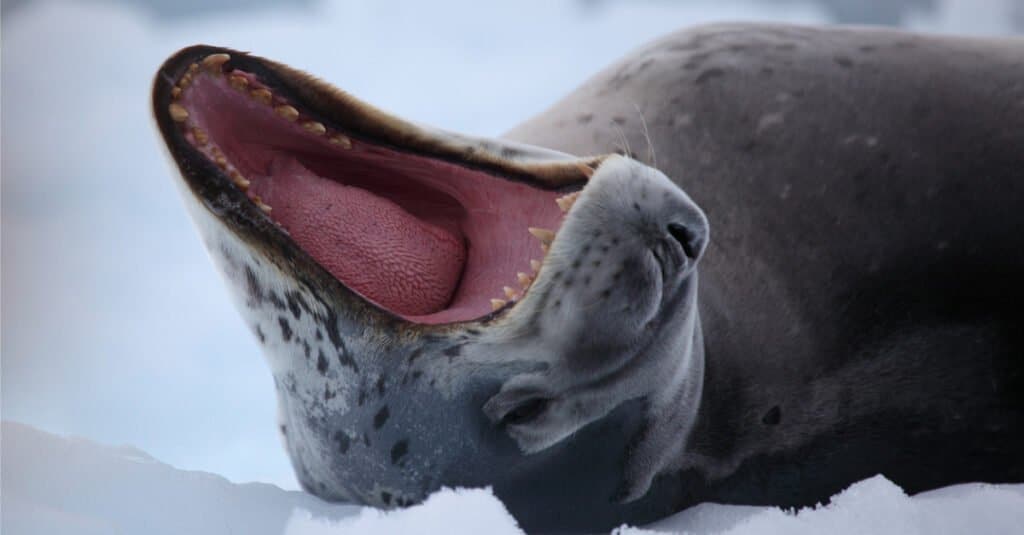
Leopard
seals prey on Gentoo penguins.
©iStock.com/MogensTrolle
Usually, leopard seals, orcas, and sea lions are the main creatures that prey on penguins. However, this is the case only near or in the water. On land, these penguins have few threats except that from humans. Mankind has often hunted them and is affected by pollution and climate change. Several birds also like to prey on Gentoo penguin chicks including Skuas, giant petrels, kelp gulls, and the snowy sheathbill.
Reproduction, Babies, and Lifespan
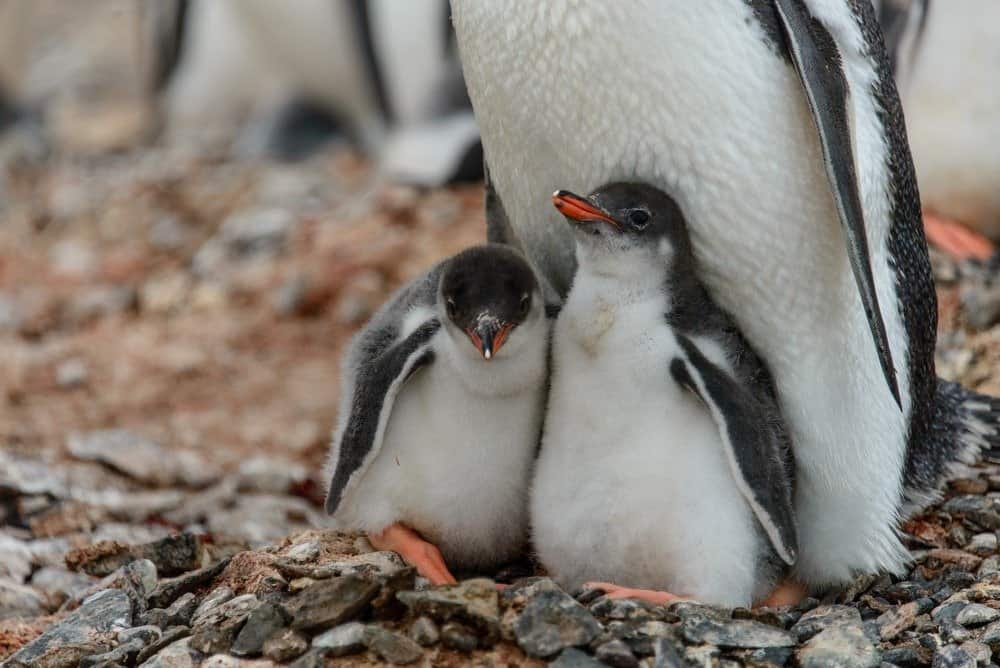
Gentoo penguin parents are monogamous and share chick-raising responsibilities.
©Alexey Seafarer/Shutterstock.com
Gentoo penguins are monogamous and usually mate for life. Monogamy is so important to them that infidelity is often punished by banishment from the colony. Gentoos fashion nests out of pebbles and are known to be quite particular about it. A male Gentoo can win the favor of a female during courtship by presenting her with a beautiful rock. Nests are made from a circular pile of carefully selected stones and are guarded with the utmost attention. Many fights occur over these prized pebbles during nesting season – a time when the usually laid-back birds bristle with energy and seem aware of the important task they are undertaking.
Two eggs are laid into the perfectly prepared nest. Both parents share incubation duties by taking turns daily. The eggs, the second of which is always smaller than the first, usually hatch five weeks after they are laid. Then, active parenting begins as the penguin couple works together to protect and feed their little chicks. Gentoo parents are very protective and nurturing for the month that the babies stay in the nest – and after, when the chicks graduate to creches – nursery schools within the colony where they will spend their childhoods.
Usually around January, around three months after they are born, the chicks start developing their adult feathers and going out on their own. They usually go out to sea at around 80 to 100 days after their birth.
However, sadly, their survival often depends on food availability. If ever, a situation relating to the lack of food arises, the parents might have to decide to feed the stronger of their babies while making a tough choice to sacrifice their relatively weaker baby.
The lifespan of Gentoo Penguins is a total of 13 to 15 years. Surprisingly, the most brutal battle for life is often fought within their first year, with only about 30 to 50 percent chances that they will make it to the next.
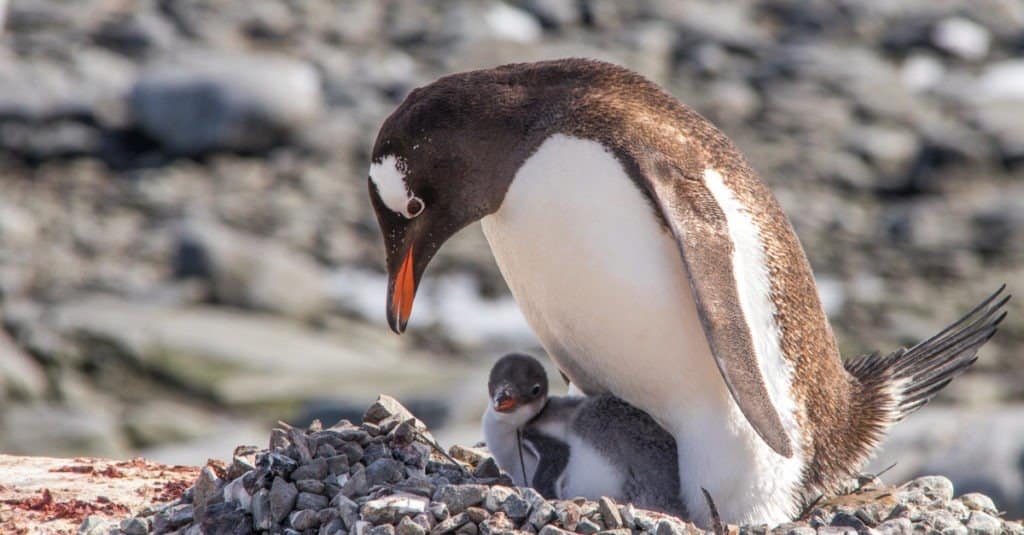
Newly hatched gentoos are gray and turn black within a week.
©Arne Beruldsen/Shutterstock.com
Population
Gentoo penguins are now listed as near threatened by the IUCN because of significant population declines. According to sources, the breeding population of the Gentoo penguins currently stands at over 380,000 pairs.
In the Zoo
Gentoo Penguins can often be kept in zoo environments and can often easily blend with minimal problems. Sources suggest that as of now, there are more than 750 Gentoo Penguins that live in zoos all around the world.
View all 170 animals that start with GGentoo Penguin FAQs (Frequently Asked Questions)
What is Gentoo Penguin?
Gentoo Penguins are creatures that are a part of the penguin families and are known as the fastest swimming penguins. They are distinguished by a white stripe that suns from their eye to eye.
Are Gentoo Penguins endangered?
No, they are not. They are, in fact, the only known penguins that are known to be increasing in numbers and domains. However, while in some regions, their population is increasing, in some other regions, it is also decreasing drastically. They were declared ‘nearly threatened’ by the IUCN in the year 2007.
How did these penguins get their name?
Well, the origin of their name might not be known but it is often said that they get their Latin name from the style of their tails that are longer as compared to the other penguins.
Is there a unique feature related to the Gentoo penguins?
Black in color from back to head, the Gentoo Penguins are most distinguished by the white strip at the top of their head that runs from eye to eye. Otherwise, they have a white patch on their bellies much like the other penguins.
How fast does the gentoo penguin swim?
The Gentoo penguins are known to be the fastest swimming penguins. They can swim about 22 miles per hour.
Are gentoo penguins carnivores, herbivores, or omnivores?
Gentoo penguins are usually carnivores.
How long do Gentoo Penguins live?
Gentoo penguins usually live for 13 to 15 years.
What does Gentoo Penguins eat?
The Gentoo penguins usually eat fish. About 15% of their diets comprise of fish. However, depending on the season and the place that they’re currently in, these penguins eat what they can find.
How tall are Gentoo Penguins?
Gentoo Penguins are usually 30 inches tall.
What Kingdom do Gentoo Penguins belong to?
Gentoo Penguins belong to the Kingdom Animalia.
How do Gentoo Penguins have babies?
Gentoo Penguins lay eggs.
Thank you for reading! Have some feedback for us? Contact the AZ Animals editorial team.
Sources
- David Burnie, Dorling Kindersley (2011) Animal, The Definitive Visual Guide To The World's Wildlife
- Tom Jackson, Lorenz Books (2007) The World Encyclopedia Of Animals
- David Burnie, Kingfisher (2011) The Kingfisher Animal Encyclopedia
- Richard Mackay, University of California Press (2009) The Atlas Of Endangered Species
- David Burnie, Dorling Kindersley (2008) Illustrated Encyclopedia Of Animals
- Dorling Kindersley (2006) Dorling Kindersley Encyclopedia Of Animals
- Christopher Perrins, Oxford University Press (2009) The Encyclopedia Of Birds
- National Geographic, Available here: https://www.nationalgeographic.com/animals/birds/g/gentoo-penguin/
- Oceanwide Expeditions, Available here: https://oceanwide-expeditions.com/to-do/wildlife/gentoo-penguin
- Wikipedia, Available here: https://en.wikipedia.org/wiki/Gentoo_penguin
- Seaworld Parks & Entertainment, Available here: https://seaworld.org/animals/facts/birds/gentoo-penguin/
- Travel Wild Expeditions, Available here: https://travelwild.com/wildlife/antarctica-wildlife/gentoo-penguin/
- Animal Diversity Web, Available here: https://animaldiversity.org/accounts/Pygoscelis_papua/
- Australian Antarctic Program, Available here: https://www.antarctica.gov.au/about-antarctica/animals/penguins/gentoo-penguins/

